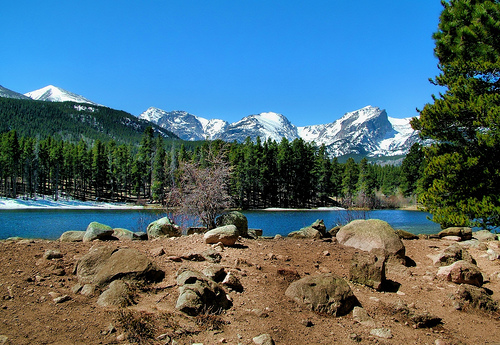

Location: Boulder, Grand, Larimer Counties, CO Map
Area: 265,761 acres (107,550 ha)
Rocky Mountain National Park is a national park in the center-north of the state of Colorado in the United States. The park is located northwest of the city of Boulder in the heart of the Rocky Mountains. It is crossed by the Colorado River. It was established in 1915 and in 2007 it received 2,991,528 visitors. It is managed by the National Park Service. Rocky Mountain National Park covers an area of 1,076 km². It is divided by the continental divide that gives the eastern and western parts of the mountain range, which gives a different character to both halves of the park. The eastern part tends to be drier with peaks covered with glaciers and glacial cirques. The western part is more humid with deep forests that dominate the landscape. The park contains some 150 lakes and 60 summits of more than 3,700 meters. A quarter of the Rocky Mountain National Park is above the arboreal limit. The highest point is the Longs Peak that reaches the 4,346 meters above sea level.
The lower parts are occupied by forests and
mountain meadows. Pinus ponderosa, which prefers the drier areas,
dominates to the highest areas where Douglas fir replaces the
ponderosa. Starting at 2,700 meters, the subalpine forest begins,
where the Engelmann spruce and the alpine spruce are common. Above
the arboreal limit at about 3,500 meters the trees disappear and the
alpine meadow appears in these areas.
July and August are the
hottest months in the park with temperatures that exceed 27 ° C but
it is possible to fall below 0⁰ at night. There are often storms in
the afternoon. Thunder is particular dangerous at the area above
tree line. Snowfall occurs from mid-October to the end of May.
Entrance fees are $20 per private vehicle or $10
for individuals on foot or on bicycle, valid for seven days. There
is a $40 pass available that allows entry into Rocky Mountain
National Park for one year.
There are several passes for
groups traveling together in a private vehicle or individuals on
foot or on bike. These passes provide free entry at national parks
and national wildlife refuges, and also cover standard amenity fees
at national forests and grasslands, and at lands managed by the
Bureau of Land Management and Bureau of Reclamation. These passes
are valid at all national parks including Rocky Mountain National
Park:
The $80 Annual Pass (valid for twelve months from date
of issue) can be purchased by anyone. Military personnel can obtain
a free annual pass in person at a federal recreation site by showing
a Common Access Card (CAC) or Military ID.
U.S. citizens or
permanent residents age 62 or over can obtain a Senior Pass (valid
for the life of the holder) in person at a federal recreation site
for $80, or through the mail for $90; applicants must provide
documentation of citizenship and age. This pass also provides a
fifty percent discount on some park amenities. Seniors can also
obtain a $20 annual pass.
U.S. citizens or permanent residents
with permanent disabilities can obtain an Access Pass (valid for the
life of the holder) in person at a federal recreation site at no
charge, or through the mail for $10; applicants must provide
documentation of citizenship and permanent disability. This pass
also provides a fifty percent discount on some park amenities.
Individuals who have volunteered 250 or more hours with federal
agencies that participate in the Interagency Pass Program can
receive a free Volunteer Pass.
4th graders can receive an Annual
4th Grade Pass that allows free entry for the duration of the 4th
grade school year (September-August) to the bearer and any
accompanying passengers in a private non-commercial vehicle.
Registration at the Every Kid in a
Rocky Mountains Park website
is required.
In 2018 the National Park Service will offer four
days on which entry is free for all national parks: January 15
(Martin Luther King Jr. Day), April 21 (1st Day of NPS Week),
September 22 (National Public Lands Day), and November 11 (Veterans
Day weekend).
If you drive in early in the morning or late at
night the fee booth will probably be unmanned. It is rumored that
local Larimer County and Grand County residents can pass through the
park without paying a fee if they mention that intention to the
entrance guards.
The park is naturally divided into two parts - eastern and western.
The eastern part has a dry climate, ice peaks and kars. In the western
part, there is a humid climate and an abundance of forests.
Mountain roads have a total length of 578 km, the park has 150 lakes
(including the largest in terms of area in depth in the state - Grand
Lake) and 720 km of streams and rivers. In addition, there are 60 peaks
over 3,700 m, the highest of which is Longs Peak (4,345 m).
The warm months are July and August, when the temperature reaches above 25 ° C, although it can often fall below zero at night. Thunderstorms are not uncommon. Heavy snowfalls begin in mid-October and continue until May. Spring is wet, with alternating rain and snow. In rare cases, precipitation in the form of snow can fall until July. In the western part, as a rule, more precipitation falls than in the eastern part.
Alpine meadow flowers stand the test of the harsh climate, blooming from April to September. The most common trees are pines. At higher elevations, trees disappear, giving way to endless tundra and meadows. The park is known for large animal species such as wapiti and bighorn, here you can see various types of hummingbirds, squirrels and other species.